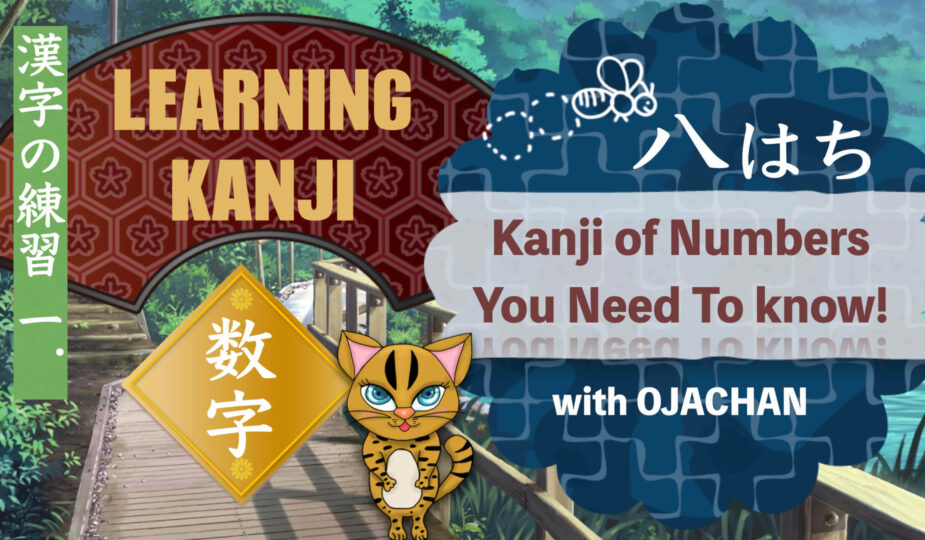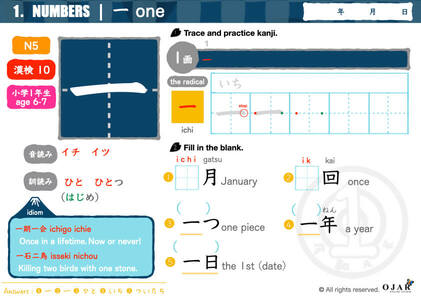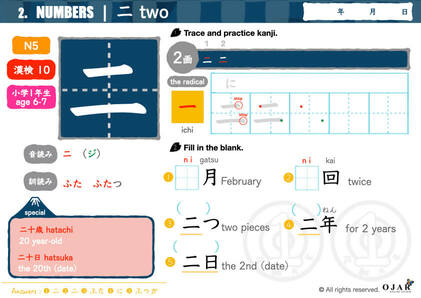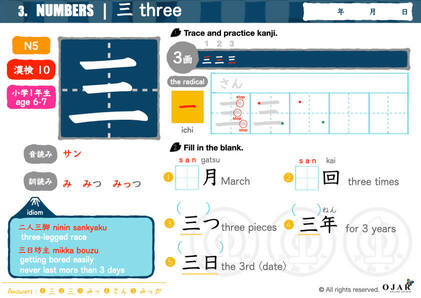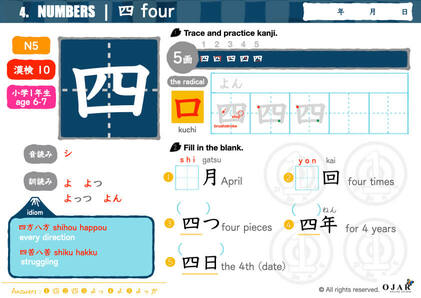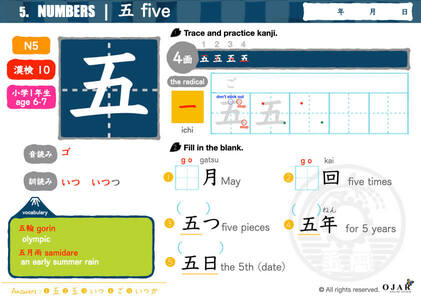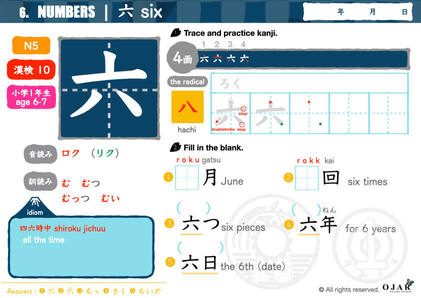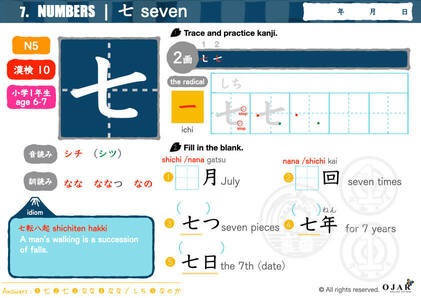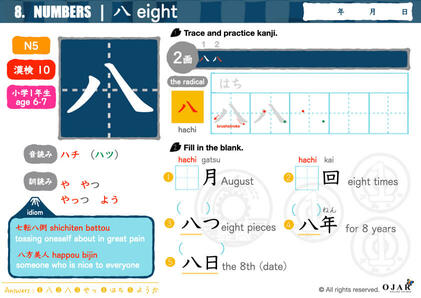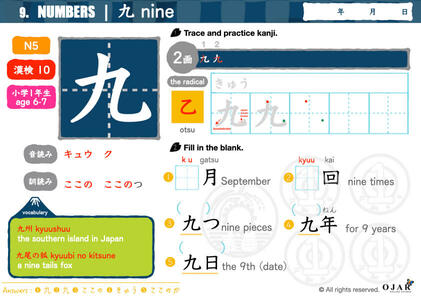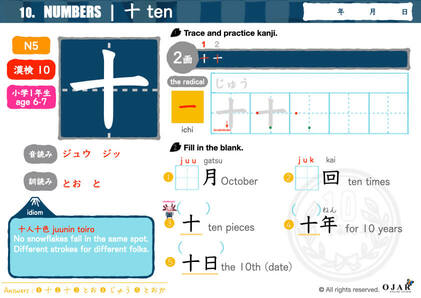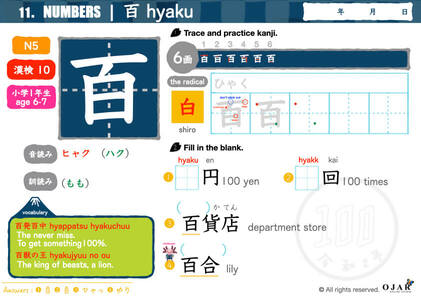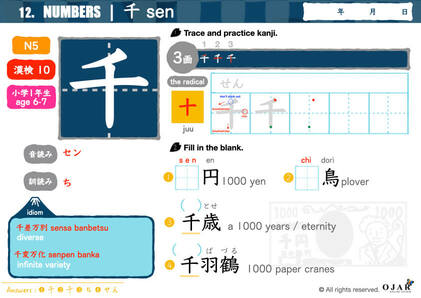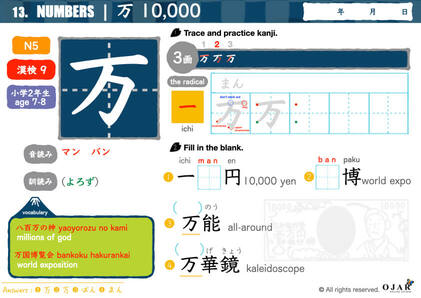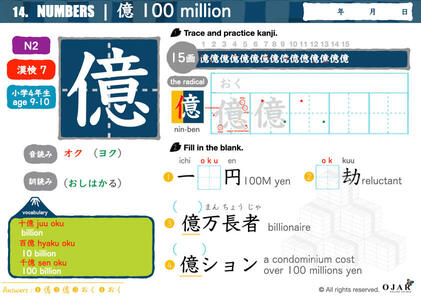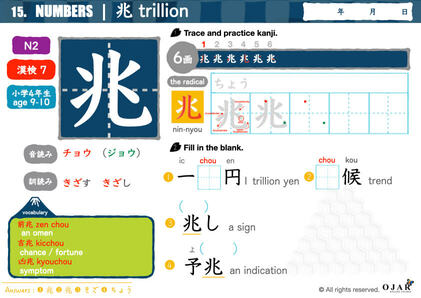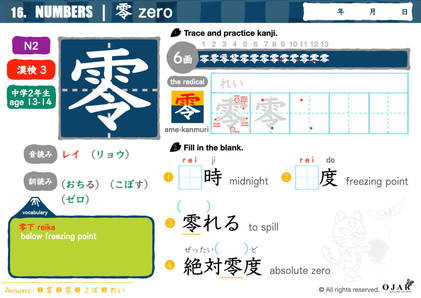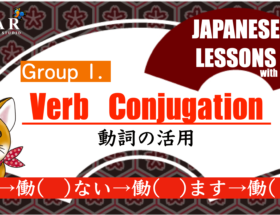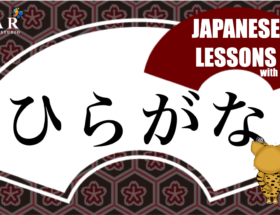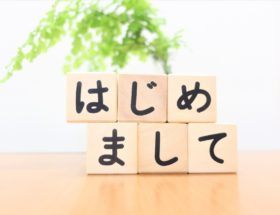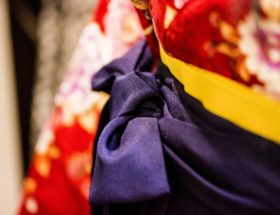こんにちは、おじゃちゃんです🐶Today’s lesson is “Kanji Exercise 1 | number 数字”.
The most important thing in Language study is vocabulary. There are 2,136 words of Kanji on JLPT.
You have to practice kanji a lot because you need to learn the way of reading and using it, and how to write the stroke order and the radical in a kanji.
Let’s learn kanji as you learn the vocabulary!
KANJI Dictionary 2500 (Japanese)
Customer Reviews: ★★★★☆
Publisher : ナツメ社 (July, 18th 2019)
CONTENTS
Kanji Exercise | Number 数字
Kanji Number 1|一 いち
Is it very simple, right? Write it horizontally with confidence. We sometimes read the particular way of this kanji depending on the combination. It is often used for proverbs.
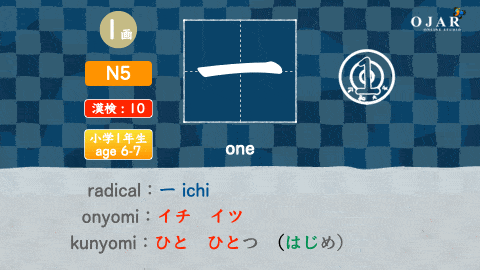
| Japanese | English |
|---|---|
| 一回 ikkai | once |
| 一時 ichiji | 1 o’clock |
| 一番目 ichibanme | the first |
| 一つ hitotsu | one piece |
| ★一日 tsuitachi | first (date) |
| 一月 ichigatsu | January |
| ★一昨日 ototoi | the day before yesterday |
| ★一昨年 ototoshi | last year |
| 一期一会 ichigo ichie | Once in a lifetime! Now or never! |
| 一石二鳥 isseki nichou | Killing two birds with one stone. |
Kanji Number 2|二 に
The 1st stroke is shorter than the 2nd stroke. We sometimes read the particular way of this kanji depending on the combination.
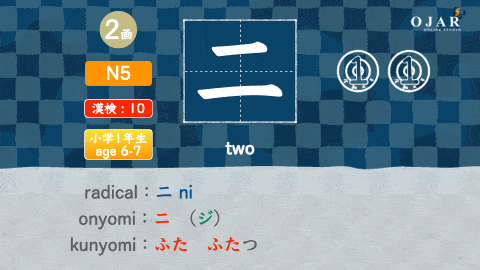
| Japanese | English |
|---|---|
| 二回 nikai | twice |
| 二時 niji | 2 o’clock |
| 二番目 nibanme | the second |
| 二つ futatsu | two pieces |
| ★二日 futsuka | second (date) |
| 二月 nigatsu | February |
| ★二十日 hatsuka | twentieth (date) |
| ★二人 futari | two people |
| ★二十歳 hatachi | 20-year-old |
| 唯一無二 yuiitsu muni | only |
Kanji Number 3|三 さん
The point is that a 3rd, 1st, and 2nd strokes have length decreasing in this order. For personal names, it is often read “ぞう” like a former prime minister “安倍 晋三 Shinzo Abe“.
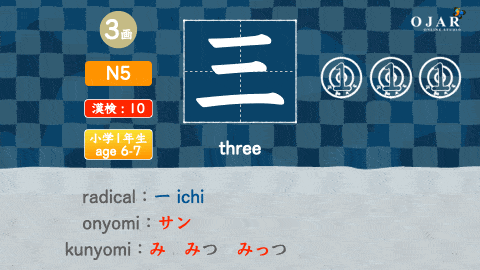
| Japanese | English |
|---|---|
| 三回 sankai | three times |
| 三時 sanji | 3 o’clock |
| 三番目 sanbanme | the third |
| 三角 sankaku | triangle |
| 三つ mittsu | three pieces |
| 三日月 mikazuki | crescent moon |
| ★三日 mikka | third (date) |
| 三月 sangatsu | March |
| 二人三脚 ninin sankyaku | three-legged race |
| 三日坊主 mikka bouzu | getting bored easily never last more than 3 days |
Kanji Number 4|四 し or よん
Make the 4th stroke curve rightward. In Japan, this onyomi of the number is often avoided using because this number means same as “死 shi the death”.
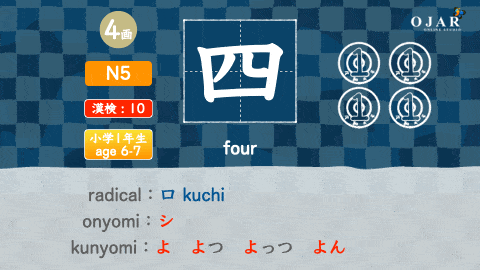
| Japanese | English |
|---|---|
| 四回 yonkai | four times |
| 四時 yoji | 4 o’clock |
| 四番目 yonbanme | the fourth |
| 四角 shikaku | square |
| 四つ yottsu | 4 pieces |
| 四季 shiki | 4 seasons |
| 四日 yokka | fourth (date) |
| 四月 shigatsu | April |
| 四方八方 shihou happou | every direction |
| 四苦八苦 shiku hakku | struggling |
Kanji Number 5|五 ご
The important thing is the consciousness of the space in the 3rd stroke. There are 5important events, which is called “5節句 go-sekku 5 seasonal festivals (January 7th, March 3rd, May 5th, July 7th, and September 9th)”, in Japan.
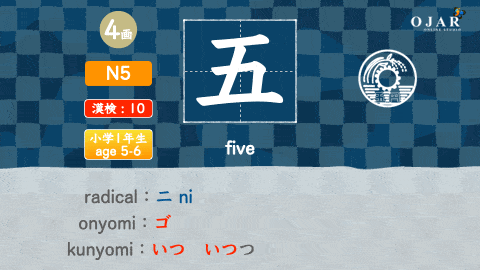
| Japanese | English |
|---|---|
| 五回 gokai | five times |
| 五時 goji | 5 o’clock |
| 五番目 gobanme | the fifth |
| 五角形 gokakkei | pentagon |
| 五つ itsutsu | 5 pieces |
| 五輪 gorin | olympic |
| 五日 itsuka | fifth (date) |
| ★五月 gogatsu | May |
| ★五月雨 samidare | an early summer rain |
| 五里霧中 gorimuchuu | in the dark |
Kanji Number 6|六 ろく
Be careful with the angle of the 2nd and 3rd stroke. In the Japanese calendar, there is the special counting way of days, which is called “六曜 roku-you (先勝 senshou, 友引 tomobiki, 先負 senbu, 仏滅 butsumetsu 大安 taian, and 赤口 syakkou)”, it tells fortune in a 6-day cycle following the lunar calendar. We usually use this when we have a ceremonial occasion such as a marriage ceremony or a funeral according to an old custom.
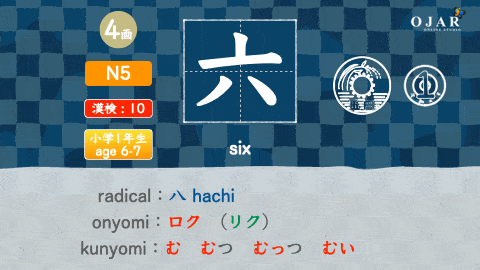
| Japanese | English |
|---|---|
| 六回 rokkai | six times |
| 六時 rokuji | 6 o’clock |
| 六番目 rokubanme | the sixth |
| 六角形 rokkakei | hexagon |
| 六つ muttsu | 6 pieces |
| 双六 sugoroku | a board game played with dice |
| 六日 muika | sixth |
| 六月 rokugatsu | June |
| ★十六夜 izayoi | the moon on 16th night on the lunar calendar |
| 四六時中 shiroku jichuu | every time |
Kanji Number 7|七 しち or なな
At the end of the brushstroke, you can write the upward brushstroke, but we usually stop it at the end. We often use “nana” more than “shichi” because shichi’s pronunciation is harder than nana. In Japan, when we write the number 7, we write like a “7”, it is not like a “ヌ”, which is the western-style.
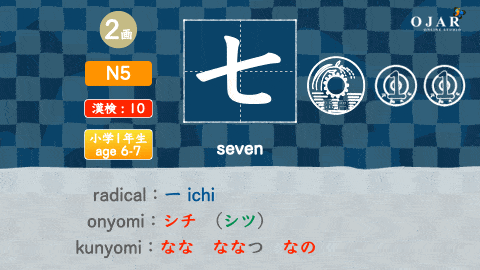
| Japanese | English |
|---|---|
| 七回 (shichikai) *original nanakai *common | 7 times |
| 七時 shichiji nanaji | 7 o’clock |
| 七番目 shichibanme nanabanme | the seventh |
| 七つ nanatsu | tsu 7 pieces |
| 七日 nanoka | seventh (date) |
| 七月 shichigatsu nanagatsu | July |
| 七福神 shichifukujin | seven gods |
| ★七夕 tanabata | the star day |
| ★七五三縄 shimenawa | twisted straw rope |
| 七転八起 shichiten hakki nanakorobi yaoki | A man’s walking is a succession of falls. |
Kanji Number 8|八 はち
Be careful with the angle.
Kanji of 八 is called “末広がり suehirogari to prosper more and more”, we treat this kanji as good luck.
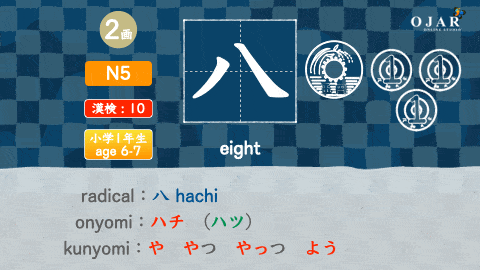
| Japanese | English |
|---|---|
| 八回 hachikai | eight times |
| 八時 hachiji | 8 o’clock |
| 八番目 hachibanme | the eighth |
| 八つ yattsu | 8 pieces |
| 八日 youka | eighth (date) |
| 八月 hachigatsu | August |
| 八百長 yaochou | a fix |
| 八百屋 yaoya | a fruit and vegetable store |
| ★七転八倒 shichiten battou | tossing oneself about in great pain |
| 八方美人 happou bijin | someone who is nice to everyone |
Kanji Number 9|九 きゅう or く
The important thing is writing the upward brushstroke at the end. We associate 9 with “苦しむ kurushimu suffering” so we have a bad image for this number.
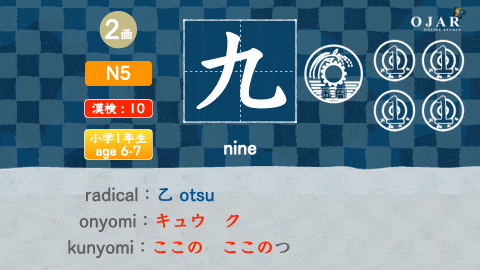
| Japanese | English |
|---|---|
| 九回 kyuukai | nine times |
| 九時 kuji | 9 o’clock |
| 九番目 kyuubanme | the ninth |
| 九つ kokonotsu | 9 pieces |
| 九日 kokonoka | ninth (date) |
| 九月 kugatsu | September |
| 九九 kuku | multiplication of 1 to 9 times tables |
| 九州 kyuushuu | Kyushu region |
| 九尾の狐 kyuubi no kitsune | nine tails fox |
| 九死に一生 kyuushi ni isshou | narrowly escape death |
Kanji Number 10|十 じゅう
Be careful with the stroke order. You can express other numbers like a “20 二十, 30 三十, 40 四十…” with this kanji.
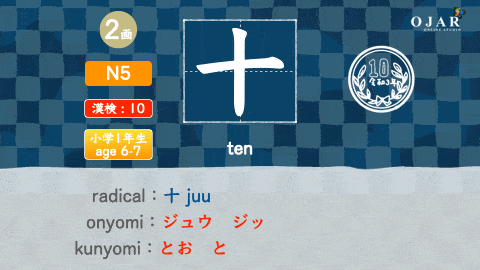
| Japanese | English |
|---|---|
| 十 juu | ten |
| 十時 juuji | 10 o’clock |
| 十番目 juubanme | the tenth |
| ★十 *十つ is wrong! too | ten pieces |
| 十日 tooka | tenth (date) |
| 十月 juugatsu | October |
| 十字架 juujika | cross |
| 十分 juubun | plenty |
| 十人十色 juunin toiro | No snowflakes fall in the same spot. Different strokes for different folks. |
| 一を聞いて十を知る ichi wo kiite juu wo shiru | to understand quickly |
■ Numbers More Than 11
We express numbers more than 11 by putting other numbers together.
| number | Japanese |
|---|---|
| 11 | 十一 juu-ichi |
| 12 | 十二 juu-ni |
| 13 | 十三 juu-san |
| 20 | 二十 nijuu |
| 24 | 二十四 nijuu-shi nijuu-yon |
| 25 | 二十五 nijuu-go |
| 30 | 三十 sanjuu |
| 40 | 四十 shijuu yonjuu |
| 50 | 五十 gojuu |
| 99 | 九十九 kyuujyuu-kyuu kyuujuu-ku |
Kanji Unit 100|百 ひゃく
Be careful for the 2nd stroke not to stick out to the 1st.
In Japan, we celebrate the birthday of the 100th day since the baby was born, which is called “百日祝い momoka-iwai” or “お食い初め okuizome”.
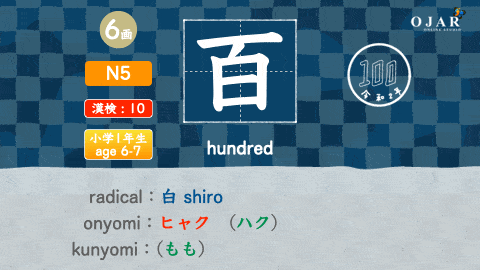
| Japanese | English |
|---|---|
| 百 hyaku | 1 hundred |
| 百円 hyakuen | 100 yen |
| ★百日 hyakunichi / momoka | 100 days |
| 百貨店 hyakkaten | department store |
| 百科事典 hyakka jiten | encyclopedia |
| ★百合 yuri | lily |
| 百獣の王 hyakujuu no ou | the king of beasts, lion |
| 百も承知 hyaku mo shouchi | well known |
| 百戦錬磨 hyakusen renma | the never miss to get something 100% |
| 百発百中 hyappatsu hyakuchuu | The king of beasts, a lion. |
Kanji Unit 1,000|千 せん
Be careful with the angle of the 1st stroke.
The famous literature “The Arabian Nights” is called “千夜一夜物語 senya-ichiya-monogatari” in japan.
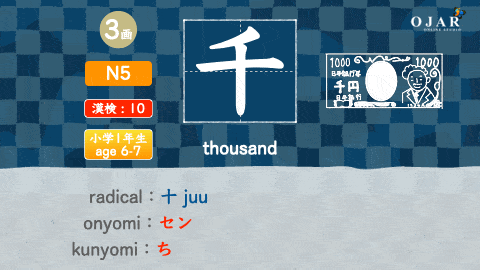
| Japanese | English |
|---|---|
| 千 sen | 1 thousand |
| 千円 senen | 1000 yen |
| 千歳 chitose | a 1000 years / eternity |
| 千羽鶴 senbazuru | one thousand paper cranes for luck |
| 千代紙 chiyogami | origami |
| 千鳥足 chidoriashi | stagger |
| 千切り sengiri | shred |
| 千と千尋の神隠し sen to chihiro no kamikakushi | “Spirited Away” Ghibli movie |
| 千差万別 sensa banbetsu | diverse |
| 千変万化 senpen banka | infinity variety |
Kanji Unit 10K|万 まん
Be careful with the stroke order, especially the 2nd one.
万 means “a large number of … or an all-around”.
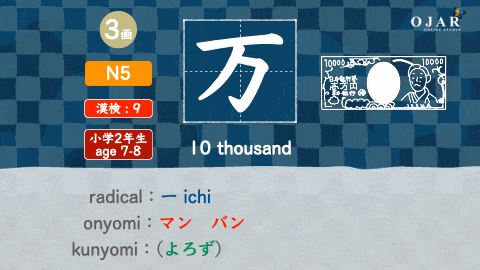
| Japanese | English |
|---|---|
| 万 man | 10,000 |
| 一万円 ichimanen | 10,000 yen |
| 万歳 banzai | hurray! |
| 万能 bannou | all-around |
| 万引き manbiki | shoplifting |
| 万一 / 万が一 manichi / mangaichi | in an emergency |
| 万華鏡 mangekyou | keleidoscope |
| 万国博覧会 / 万博 bankoku hakurankai / banpaku | World Expo |
| 八百万の神 yaoyorozu no kami | millions of gods |
Kanji Unit 100M|億 おく
It’s a complicated kanji for the intermediate level of Japanese, so you can memorize the parts by dividing “へん” and “つくり”. You can find this kanji only related to the words of money or distance.
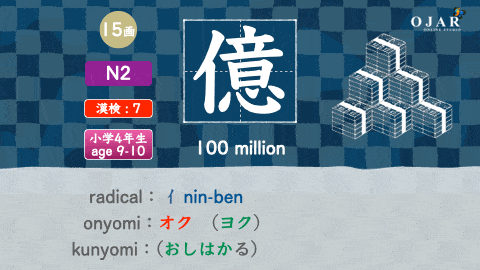
| Japanese | English |
|---|---|
| 億 oku | hundred million |
| 億円 okuen | hundred million yen |
| 一億 ichioku | a hundred million |
| 十億 juuoku | billion |
| 百億 hyakuoku | 10 billion |
| 千億 senoku | 100 billion |
| 億ション okushon | a condominium cost over 100 millions yen |
| 虹村億泰 nijimura okuyasu | a character of “JoJo’s Bizarre Adventure” |
| 億劫 okkuu | reluctant |
| 億万長者 okuman chouja | billionaire |
Kanji Unit 1012|兆 ちょう
You can only find this kanji when you read a business magazine or news about the national budget, so I think you can learn numbers till here for your daily life.
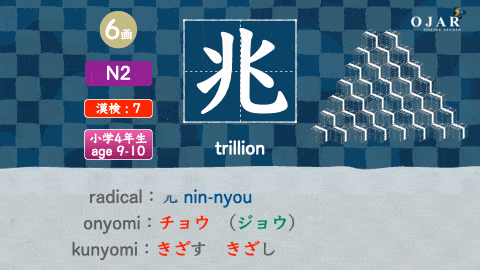
| Japanese | English |
|---|---|
| 兆 chou | trillion |
| 一兆 icchou | a trillion |
| 十兆 jucchou | 10 trillion |
| 百兆 hyakuchou | 100 trillion |
| 兆し kizashi | a sign |
| 兆候 choukou | an omen / trend |
| 前兆 zenchou | an omen |
| 予兆 yochou | an indication |
| 吉兆 kicchou | chance / fortune |
| 凶兆 kyouchou | symptom |
Kanji Number 0 | 零 れい
We pronounce this kanji “れい”, but we usually use “ゼロ” of Katakana instead. And we sometimes call 0 as “まる” on a room number or a telephone number.
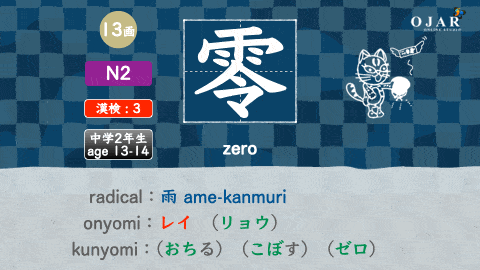
| Japanese | English |
|---|---|
| 零 rei | zero / none |
| 零時 reiji | midnight |
| 零歳 reisai | a baby less than twelve months |
| 零点 reiten | no points on the exam |
| 零度 reido | freezing point |
| 零下 reika | below freezing point |
| 絶対零度zettaireido | absolute zero |
| 零れる koboreru | to spill |
| 零れ話 kobore banashi | tidbits |
| EVA 零号機 EVA zerogouki | Evangelion Unit-01 -“Neon Genesis Evangelion” anime |
How to Count Numbers in Japanese?
The Japanese-style counting way of a unit is different from the western-style.
The western-style counting way is that the unit changes each “000” like a “1,000 thousand, 1,000,000 million, 1,000,000,000 billion…”. But the Japanese-style counting way is that the unit changes each “0000” like a “10,000 万, 100,000,000 億 1,000,000,000,000 兆…”.
■ Units More Than 兆
If you are a huge fan of Japanese, you can learn this unit as 雑学! We hardly use these units.
| units | Japanese |
|---|---|
| 1 | 一 ichi |
| 10 | 十 juu |
| 100 | 百 hyaku |
| 1,000 | 千 sen |
| 10,000 | 万 man |
| 108 | 億 oku |
| 1012 | 兆 chou |
| 1016 | 京 kyou |
| 1020 | 垓 gai |
| 1024 | (禾予) *a combined kanji jo |
| 1028 | 穰 jou |
| 1032 | 溝 kou |
| 1036 | 澗 kan |
| 1040 | 正 sei |
| 1044 | 載 sai |
| 1048 | 極 goku |
| 1052 | 恒河沙 gougasha |
| 1056 | 阿僧祇 asougi |
| 1060 | 那由他 nayuta |
| 1064 | 不可思議 fukashigi |
| 1068 | 無量大数 muryoutaisuu |
Besides, Japanese-style counting ways are different depending on the things or animals and so on.
I’m going to tell you about this topic next time!
Okey, that’s all for today!
Good luck with your Kanji Exercise!
KANJI Dictionary 2500 (Japanese)
Customer Reviews: ★★★★☆
Publisher : ナツメ社 (July, 18th 2019)
THE NEXT LESSON is:
Kanji Exercise 2 | Year, Month, And Week
THE PREVIOUS LESSON is:
Kanji Exercise | How to Learn Kanji?

